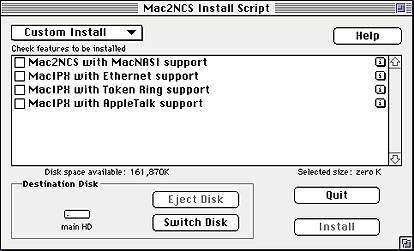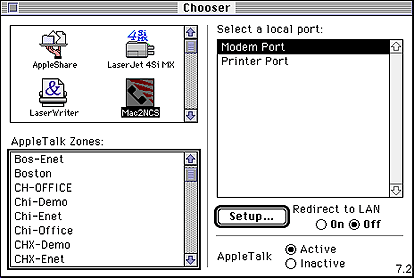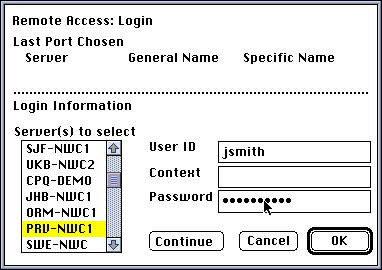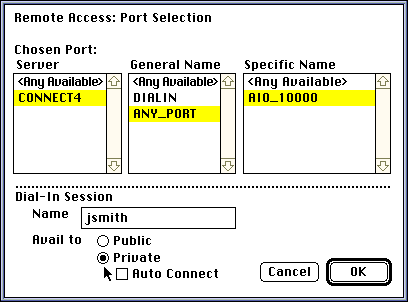

  |
This section describes how to use the Mac2NCS software and a third-party communications application to dial out from the network and access a bulletin board, host computer, or other resource---or to dial in and remotely control a dedicated LAN workstation. Mac2NCS is a redirector program that redirects the COM port I/O for Macintosh communications applications to a NASI port on a NetWare server.
Locate the Remote Access Mac Client folder.
This folder might be on a diskette or a folder on a server.
Double-click the Installer icon.
An informational screen appears. This screen contains basic instructions for installing Mac2NCS.
Click Continue.
The Mac2NCS Install Script window appears.
Do one of the following:
Mac2NCS installs automatically.
The Custom Install options appear, as shown in Figure 12.
Figure 12
Mac2NCS Install Script Window
(Conditional) If you selected Custom Install, check Mac2NCS with MacNASI Support, check the other features that you want to install, and then click Install.
For example, if you have an Ethernet network, you need to install MacIPX® with Ethernet support (if it isn't already installed), but you do not need to install MacIPX with token-ring support.
Click Install.
Select Restart.
Novell recommends that you also install the IPXNetStat diagnostic utility, if it is not already installed on the Macintosh.
To install IPXNetStat, complete the following steps.
Locate the Remote Access Services Mac Client folder.
This folder might be a diskette or a folder on a server.
Open the NetWare Connect MAC Client folder.
Open the Mac2NCS folder.
Drag the IPXNetStat icon from the Mac2NCS folder to the System folder of your boot drive.
The IPXNetStat icon appears in the Apple Menu.
After you have installed Mac2NCS and restarted the Macintosh, you can configure Mac2NCS.
HINT: If you need additional help configuring Mac2NCS, you can activate the Apple balloon help system by clicking the balloon icon in the upper-right corner of your screen.
To configure Mac2NCS, complete the following steps.
From the Apple menu, select the Chooser.
Find and click the Mac2NCS icon.
The Chooser window appears, as shown in Figure 13.
Figure 13
Mac2NCs Chooser Window
The modem and printer ports are displayed in the right portion of the window.
Select the local port that will be used for redirection (Modem Port or Printer Port).
If the application that you will use is enabled for the Communications Tool Box, Step 3 and Step 4 are not necessary. Proceed to Step 5. If you are unsure that the application that you will use is enabled for the Communications Tool Box, proceed with Step 3 and Step 4.
Once a port is chosen for redirection, the port is not available to a physical device such as a printer or modem. Applications that are enabled for the Communications Tool Box allow you retain the physical port while using a virtual serial device for Mac2NCS.
Click On to enable redirection.
Click Setup.
The Login Information window appears, as shown in Figure 14.
Figure 14
Login Information Window
The Server(s) to Select window shows the available servers. The Last Port Chosen field shows the server name, general name, and specific name for the last NASI port that was chosen.
Specify server login information as indicated in Table 11.
Table 11. Remote Access Login Information
Click Continue.
The Remote Access Port Selection window appears, as shown in Figure 15.
Figure 15
Remote Access Port Selection Window
Specify port selection information as indicated in Table 18, Conformance Options Parameters.
You can select from one or more lists in any order. A General Name of <Any Available> is not recommended. If you intend to dial out but your call is routed to a port in a DIALIN group, then you will be unable to dial out. A selection other than <Any Available> from the Server or Group list might limit the choice of port. If the specific port you have selected is not available, you might be unable to use Mac2NCS temporarily.
Table 12. Mac2NCS Port Selection Fields
When you have finished making your selections, click OK to exit the Port Selection window.
Click OK to exit the Login Information window.
When you configure Mac2NCS to allow remote users to dial in to the network, you have the following two options:
To configure Mac2NCS to allow dial-in users to select a session, complete the following steps:
Install Mac2NCS on a network workstation.
See Installing Mac2NCS.
(Conditional) If the application that you will use is not enabled for the Communications Tool Box, configure Mac2NCS to redirect printer or modem port I/O to a port that belongs to the NCS DIALIN group.
See Configuring Mac2NCS.
In the Dial-in Session options on the NetWare Connect Port Selection window, configure the following fields.
In the Name field, enter a session name.
This can be any text that you want. The text that you enter will be used to identify the session name to remote users.
Select one of the following Avail To options:
Set the communications software on the local Macintosh to host mode or call-waiting mode.
Make sure that you configure the software to use a direct connection and do not configure it to wait for a modem to answer a call.
Make sure that the remote component of the Macintosh communications package is installed.
When you configure Mac2NCS in this manner, remote users will be presented with a menu of sessions when they access the LAN. They can then select a session on a particular Macintosh.
You can also configure Mac2NCS to allow remote users to access only one particular Macintosh.
IMPORTANT: This configuration is not recommended because it consumes more resources, requires more knowledge of the server and modem setup, and might have a higher potential security risk. See your network supervisor before using this configuration.
To configure Mac2NCS to allow dial-in users access to only one Macintosh, complete the following steps.
Install Mac2NCS on a LAN workstation.
See Installing Mac2NCS.
(Conditional) If the application that you will use is not enabled for the Communications Tool Box, configure Mac2NCS to redirect Printer or Modem port I/O to a port that is configured for either dial-out or both dial-in and dial-out.
See Configuring Mac2NCS.
Make sure that the port that users will use has a dedicated phone number associated with it.
Set the communications software on the local Macintosh to host mode or to wait for a call to a modem.
In order to do this, your host Macintosh software must know what type of modem will be used to answer the call.
Make sure that the remote component of the Macintosh communications package is installed.
Provide remote users with the phone number for the port that will be directly connected to the host Macintosh.
When you configure Mac2NCS in this manner, remote users will interact directly with the host computer.
You can use Mac2NCS to dial out from the network or to allow a remote user to dial in to your Macintosh while it is in host mode.
To use Mac2NCS to dial out, start a supported Macintosh communications application and dial out.
For example, use the Apple Internet Connection Kit to dial out to an ISP or use an America Online* client application to dial out to America On-Line services. You could also use Microphone II to dial out to another PC or Macintosh with a similar communications program. Refer to your application documentation for detailed information.
HINT: See the Mac2NCS README file for more specific information and troubleshooting tips.
If you are using Mac2NCS with an application that enables the Macintosh Communications Tool Box, make sure that the Redirect to LAN option on the Mac2NCS Chooser Window is set to Off.
With this type of application, Mac2NCS can appear as a directly accessible serial port. By not redirecting the printer and modem ports, you can leave them free for other uses.
You can use the IPXNetStat program provided with Mac2NCS to troubleshoot problems with Mac2NCS.
To use IPXNetStat, complete the following steps.
Open the folder where IPXNetStat is installed.
If IPXNetStat was installed as an Apple menu item, go to the Apple menu and select IPXNetStat.
Double-click the IPXNetStat icon.
The IPXNetStat window appears.
Do one of the following:
Check the Query Type check box and then click Update.
IPXNetStat displays a report indicating how many servers your Macintosh can detect.
If no servers are available, click Update.
If you still do not see any servers in the list, check to make sure that MacIPX is configured correctly on your Macintosh. To do this, go to the Control Panels and click the MacIPX icon. Double-click the highlighted network interface selection and make sure that the correct frame type is selected. Also, check your physical connection to the LAN.
If none of these suggestions works, then contact your network supervisor.
  |